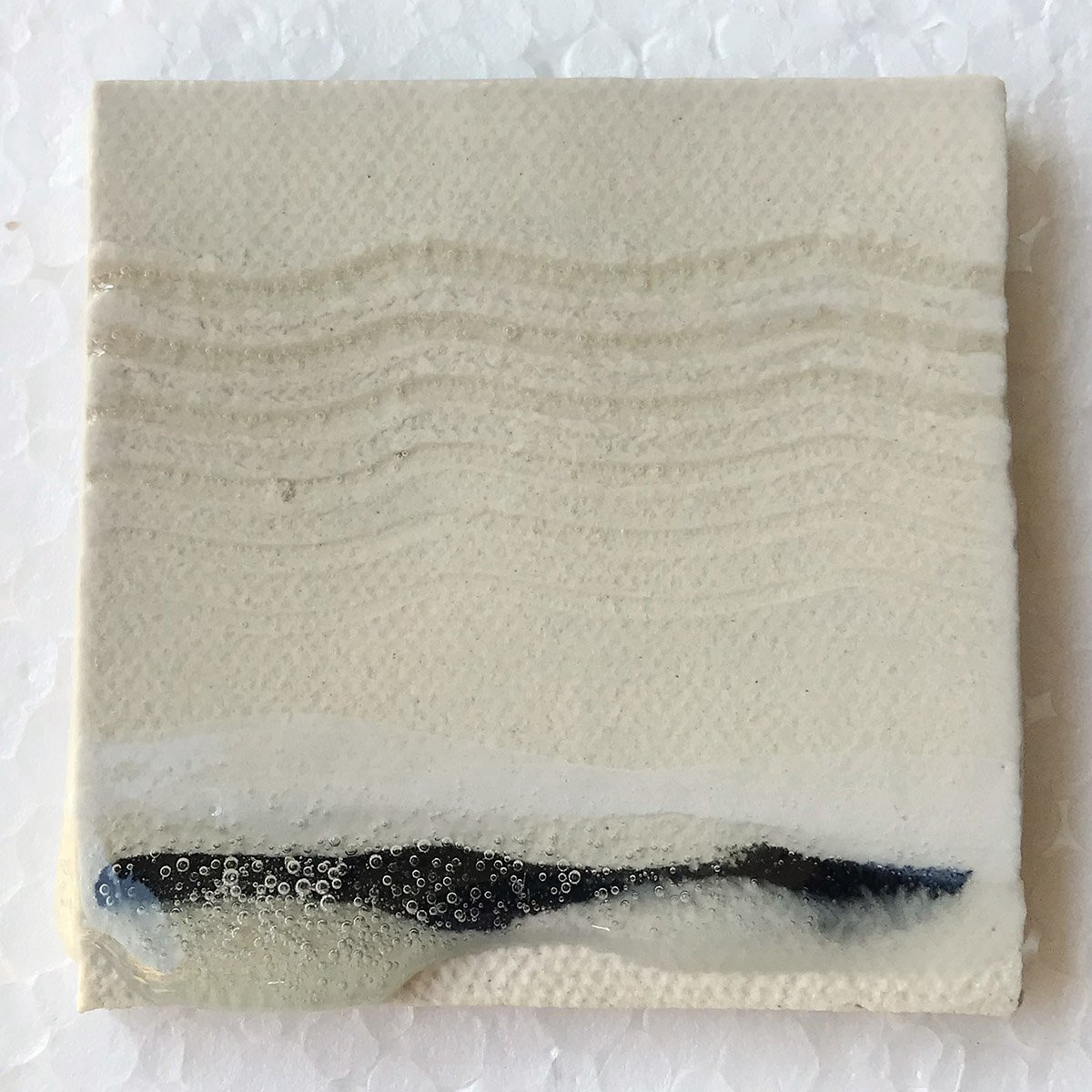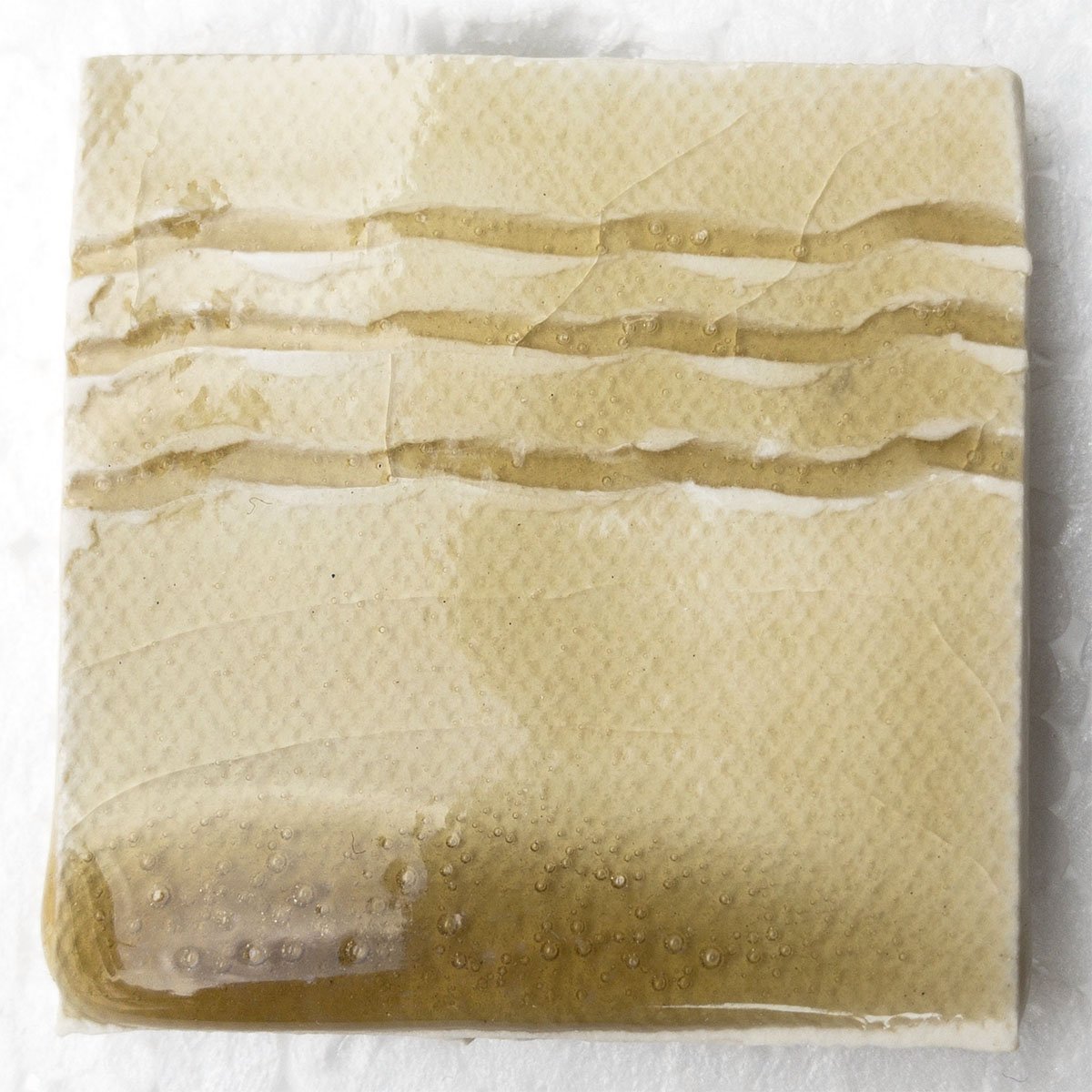Orton Cone 6 Clear Glazes
Having not fired cone 6 since college, I started by first testing a number of clear cone 6 glazes on https://glazy.org
I also studied up on cone 6 glaze chemistry via Matthew Katz's Advancing Glazes course and his papers: Boron in Glazes, Mid-Temperature Glaze Science, Glaze Safety/Durable Glazes Presentation.
Out of these tests, there were two glazes that I preferred. The first, Sue McLeod's Clear, is a soft clear with minimal clouding and has B2O3 at 0.18 which, according to Matt's information, is ideal for cone 6 glazes.
The second glaze is a shop glaze available at the Wellsville Creative Arts Center called WCAC Celadon Clear. With B2O3 at 0.45, it is really high in boron and possibly less durable than the lower-boron clears I tested. However, WCAC Celadon Clear is by far the clearest glaze I've tested, almost like a layer of pure glass or honey. Even on dark stoneware it's really clear with almost no clouding.
WCAC Celadon Clear on cone 6 porcelain
WCAC Celadon Clear on cone 6 Brooklyn Red
Being new to cone 6, I was curious as to the effect of boron levels on clear glazes. So, I created two biaxials, both with R2O fixed at 0.2. In the first Sue's Clear inspired biaxial, B2O3 is set at 0.18. In the second biaxial inspired by Celadon Clear, B2O3 is doubled to 0.36.
Each biaxial resulted in a nice clear, with the higher Boron clear being almost completely transparent and glossy, while the Boron 0.18 clear is translucent and soft.
Standard Cone 6 Porcelain Body #551
Same chart but with words describing each test glaze:
The best clear resulting from the B2O3 0.18 biaxial is here: C6 R2O 0.2 B2O3 0.18 Best Clear
In order to test the effect of higher B2O3 levels, I doubled the amount of Boron in the initial biaxial from 0.18 to 0.36 while maintaining the same R2O:RO ratio. I also made the boundaries of the tests a little higher (see map comparison). I was surprised to see that the only clear glazes in the 0.36 Boron test appear much farther down (lower in Si & Al) in the chart. But the "clear" region is still in the same Si:Al Stull region.
The best clear resulting from the B2O3 0.36 biaxial is here: C6 R2O 0.2 B2O3 0.36 Best Clear
It is similar to WCAC Celadon Clear in it's glossy, transparent quality.
High-Boron Clears
After testing WCAC Celadon Clear and seeing the results of my B2O3 0.36 biaxial, it seems there is definitely a region of very glossy, very clear glazes at higher boron levels.
Coincidentally, I tested an old glaze recipe posted to the Clayart mailing list by Laura Speirs in 1996: https://glazy.org/recipes/21102 As with the WCAC Celadon Clear, the Speirs recipe is also very high in Boron (0.51), and it also fires very clear and glossy:
VC Easy Glossy
One afternoon I began discussing the WCAC Celadon Clear with a WCAC member, Nancy Alt. I was very surprised to discover the interesting history of this glaze.
In 2009 Nancy Alt had visited Val Cushing's home and purchased a vase with a lovely blue-green celadon glaze. Nancy asked Val if he could share the glaze recipe, and he not only shared it but converted it from cone 9 to cone 6 (the temperature Nancy was firing). Val's email is copied below. It shows the extremely generous nature of this amazing potter and teacher:
From: Val Cushing
Subject: Re: celedon glaze
Date: May 12, 2009 at 12:46:57 PM EDT
To: Nancy Alt
Dear Nancy,
This glaze is one I made for C/9 oxidation electric firing, so that it would appear to be a blue green celadon. I have revised it for you to be the same color and texture only for C/6 ox. electric . I will give you two to try , first VC Pale Emerald, C/6 , glossy , blue/green , celadon looking. as follows.......... Kona F/4 feldspar 24, Ferro Frit 3134 24, Dolomite 4, whiting 14, barium carbonate 2, zinc oxide 2, flint 24, and EPK 6. ADD TO THAT , 1/2 % COPPER CARBONATE for blue green. VC/easy glossy, C/6 ox. , electric , celadon looking , green. Cornwall Stone 46, Gerstley Borate 20, Ferro Frit 3124 26, Ball Clay 8. --- add 2% copper carb. and 1/2 % red iron oxide for celadon looking green color. Test these two Nancy and if the color is not exactly what you expected let me know and we can make a revision. We may have different "tastes" about color , but we can get what you want...My pale emerald should be quite a bit like the glaze on the jar of mine you now have. and THANK YOU . Val
So it turns out that the glaze I liked so much, WCAC Celadon Clear, was actually a Val Cushing recipe called "Easy Glossy". I checked Cushing's Handbook for the recipe and didn't find it. Nor could I find similar recipes in the Glazy database. So it's quite possible this is a newly discovered Val Cushing glaze recipe.
However, the WCAC Celadon Clear had been modified from the original "Easy Glossy", most notably subbing Gerstley Borate for Gillespie Borate. I wanted to see not only the original recipe but also the color variations that Cushing was working with. So I created a triaxial blend.
Below is the triaxial blend using Copper Carbonate and Red Iron Oxide.
From Safety & Durable Glazes Presentation
From Boron in Glazes




















